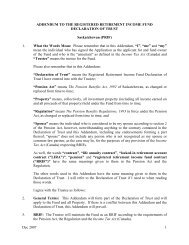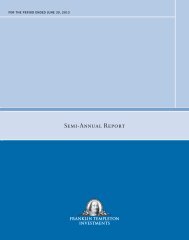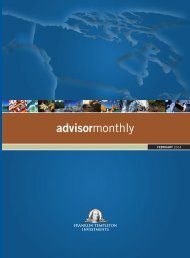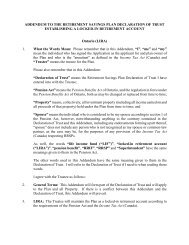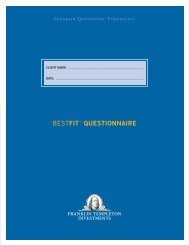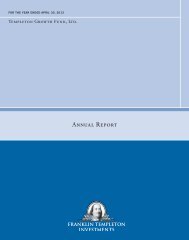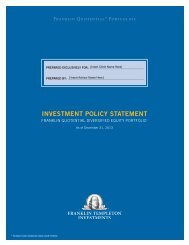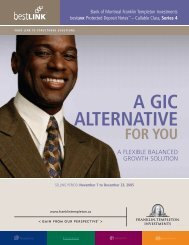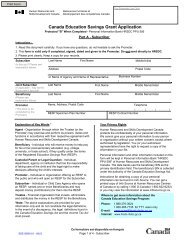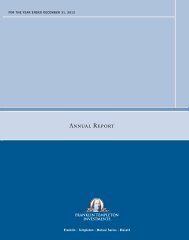accounts closed in a calendar year generally remain billable at a reduced rate through the second quarter ofthe following calendar year. In Canada, such agreements provide that accounts closed in the calendar yearremain billable for four months after the end of the calendar year. Accordingly, the level of fees will varywith the change in open accounts and the level of closed accounts that remain billable. Approximately2.1 million accounts closed in the U.S. during calendar year 2008 were no longer billable effective July 1,2009, as compared to approximately 1.7 million accounts closed during calendar year 2007 that were nolonger billable effective July 1, 2008. Approximately 0.3 million accounts closed in Canada during calendaryear 2008 were no longer billable effective May 1, 2009, as compared to approximately 0.2 millionaccounts closed during calendar year 2007 that were no longer billable effective May 1, 2008.Shareholder servicing fees decreased in fiscal year 2009 primarily due to an unfavorable currencyimpact and a 1% decrease in simple monthly average billable shareholder accounts during the year. Theunfavorable currency impact mainly resulted from a 14% decrease in value of the Canadian dollar againstthe U.S. dollar. The account decrease was predominantly related to shareholder accounts originated inCanada and the United States.Shareholder servicing fees increased in fiscal year 2008 primarily due to a 7% increase in simplemonthly average billable shareholder accounts, partially offset by an increase in shareholder accountsoriginated in Asia.Consolidated Sponsored Investment Products Income, NetConsolidated sponsored investment products income, net reflects the net investment income, includingdividend and interest income, of sponsored investment products that we consolidate in our financialstatements.Consolidated sponsored investment products income, net decreased in fiscal year 2009 and increased infiscal year 2008, reflecting the investment performance and the net asset balances of the specific sponsoredinvestment products that we consolidated during each period.Other, NetOther, net revenue primarily consists of revenues from the banking/finance segment as well as incomefrom custody services. Banking/finance revenues include interest income on loans, servicing income, andrealized and unrealized gains (losses) on residual interests from securitization transactions, and are reducedby interest expense and the provision for loan losses.Other, net revenue decreased in fiscal year 2009 primarily due to a $41.1 million higher loss fromdeclines in the fair value of residual interests from securitization transactions and a $21.8 million decreasein interest income from automobile loans, partially offset by a $12.4 million decrease in interest expense onswap contracts and a $7.6 million decrease in provision for loan losses. We have consistently followed ourmethodology in determining our allowance for loan losses, which incorporates current economic factors.Other, net revenue decreased in fiscal year 2008 primarily due to a $26.3 million increase in netrealized and unrealized losses on investments and a $10.5 million increase in provision for loan losses,partially offset by a $10.4 million increase in interest income from automobile loans.44
Operating ExpensesThe table below presents the percentage change in each expense category and the percentage of totaloperating expenses represented by each category.Percentage of TotalPercentage Change Operating Expensesfor the fiscal years ended September 30, 2009 vs. 2008 2008 vs. 2007 2009 2008 2007Underwriting and distribution .......................... (30)% (10)% 45% 49% 52%Compensation and benefits ............................ (14)% 4% 32% 28% 26%Information systems, technology and occupancy ........... (15)% 1% 9% 8% 8%Advertising and promotion ............................ (37)% (3)% 4% 5% 5%Amortization of deferred sales commissions ............... (20)% 13% 5% 5% 4%Other ............................................. (23)% (17)% 5% 5% 5%Total Operating Expenses ........................ (24)% (5)% 100% 100% 100%Underwriting and DistributionUnderwriting and distribution expenses include payments to financial advisers and other third partiesfor providing sales, marketing and distribution services to investors in our sponsored investment products.The decreases in underwriting and distribution expenses in fiscal years 2009 and 2008 were consistent withthe 30% and 12% decreases in underwriting and distribution revenues during both periods.Compensation and BenefitsCompensation and benefit expenses decreased in fiscal year 2009 primarily due to declines in salaries,wages and benefits and variable compensation. Salaries, wages and benefits decreased $123.4 million,mainly resulting from lower staffing levels and a favorable currency impact. The decrease was partiallyoffset by severance costs of $38.4 million related to reductions to our global workforce of approximately10% announced during the first half of fiscal year 2009. Variable compensation decreased $77.1 million.The decreased expenses during fiscal year 2009 reflect in part some of the actions we have taken tocontain costs, including reducing variable compensation and not providing annual merit salary increases. Asof September 30, 2009, we had approximately 7,700 employees, a decrease from approximately 8,800 atSeptember 30, 2008.Compensation and benefit expenses increased in fiscal year 2008 primarily due to annual merit salaryadjustments that were effective December 1, 2007 and higher staffing levels. Another contributing factorwas an increase in variable compensation, primarily resulting from the impact of adopting a new accountingpronouncement in October 2006 requiring us to recognize an additional compensation expense. Theseincreases were partially offset by a one-time pre-tax charge of $16.4 million recorded in fiscal year 2007and a decrease in costs related to matching contributions under our amended and restated 1998 EmployeeStock Investment Plan.We continue to place a high emphasis on our pay for performance philosophy. As such, any changes inthe underlying performance of our sponsored investment products or changes in the composition of ourincentive compensation offerings could have an impact on compensation and benefits going forward.However, in order to attract and retain talented individuals, our level of compensation and benefits mayincrease more quickly or decrease more slowly than our revenue.45
- Page 1 and 2:
G A I N F R O M O U R P E R S P E C
- Page 3 and 4: Letter to StockholdersGregory E. Jo
- Page 5 and 6: LETTER TO STOCKHOLDERSHaving announ
- Page 7 and 8: Directors and OfficersDirectorsChar
- Page 9 and 10: Performance GraphThe following perf
- Page 11 and 12: (MARK ONE)UNITED STATESSECURITIES A
- Page 14 and 15: operational and other services requ
- Page 16 and 17: A. Assets Under Management (“AUM
- Page 18 and 19: 60 days. If agreements representing
- Page 20 and 21: Similar arrangements exist with the
- Page 22 and 23: We generally operate our institutio
- Page 24 and 25: Franklin Templeton Variable Insuran
- Page 26 and 27: CATEGORY(and approximate amount of
- Page 28 and 29: The following table sets forth the
- Page 30 and 31: Korea; the Commission de Surveillan
- Page 32 and 33: COMPETITIONThe financial services i
- Page 34 and 35: or other efforts successfully stabi
- Page 36 and 37: and, consequently, we are incurring
- Page 38 and 39: such as information, systems and te
- Page 40 and 41: like our business, is based in part
- Page 42 and 43: orrowing costs and limit our access
- Page 44 and 45: director of various subsidiaries of
- Page 46 and 47: PART IIItem 5. Market for Registran
- Page 48 and 49: OverviewWe are a global investment
- Page 50 and 51: Net income decreased in fiscal year
- Page 52 and 53: Investment Management Fee RateThe f
- Page 56 and 57: Information Systems, Technology and
- Page 58 and 59: Our investments in sponsored invest
- Page 60 and 61: At September 30, 2009, we had $355.
- Page 62 and 63: Off-Balance Sheet ArrangementsAs of
- Page 64 and 65: The fair value of retained subordin
- Page 66 and 67: Indefinite-lived intangible assets
- Page 68 and 69: the position will be sustained upon
- Page 70 and 71: Selected Quarterly Financial Data (
- Page 72 and 73: The following is a summary of the e
- Page 74 and 75: Item 8.Financial Statements and Sup
- Page 76 and 77: REPORT OF INDEPENDENT REGISTERED PU
- Page 78 and 79: CONSOLIDATED BALANCE SHEETS(dollars
- Page 80 and 81: CONSOLIDATED STATEMENTS OF STOCKHOL
- Page 82 and 83: CONSOLIDATED STATEMENTS OF CASH FLO
- Page 84 and 85: Fair Value Measurements. The Compan
- Page 86 and 87: Company held interest-rate swap agr
- Page 88 and 89: not performed. If the carrying valu
- Page 90 and 91: Accumulated Other Comprehensive Inc
- Page 92 and 93: acquisition cost was allocated to t
- Page 94 and 95: FHLB borrowings and amounts availab
- Page 96 and 97: The Company recognized other-than-t
- Page 98 and 99: The changes in Level 3 assets measu
- Page 100 and 101: Changes in the allowance for loan l
- Page 102 and 103: Company sold retained subordinated
- Page 104 and 105:
Certain of the goodwill and intangi
- Page 106 and 107:
At September 30, 2009, maturities o
- Page 108 and 109:
The components of the net deferred
- Page 110 and 111:
At September 30, 2009, the banking/
- Page 112 and 113:
Total assets under management of in
- Page 114 and 115:
Stock OptionsThe following table su
- Page 116 and 117:
The following tables summarize info
- Page 118 and 119:
Operating revenues of the banking/f
- Page 120 and 121:
minimum Tier 1 and Total risk-based
- Page 122 and 123:
PART IIIItem 10. Directors, Executi
- Page 124 and 125:
Item 15.(a)(1)(a)(2)(a)(3)PART IVEx
- Page 126 and 127:
Exhibit No.Description10.17 Represe
- Page 128 and 129:
Exhibit No.Description12 Computatio
- Page 130 and 131:
Exhibit No.DescriptionEXHIBIT INDEX
- Page 132 and 133:
Exhibit No.Description10.22 Amendme
- Page 134 and 135:
(dollars in thousands)COMPUTATION O
- Page 136 and 137:
NameState or Nation ofIncorporation
- Page 138 and 139:
CONSENT OF INDEPENDENT REGISTERED P
- Page 140 and 141:
EXHIBIT 31.2CERTIFICATIONI, Kenneth
- Page 142 and 143:
CERTIFICATION PURSUANT TO 18 U.S.C.
- Page 144:
One Franklin ParkwaySan Mateo, CA 9



